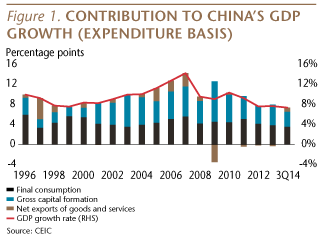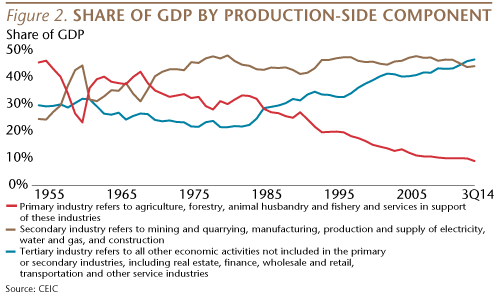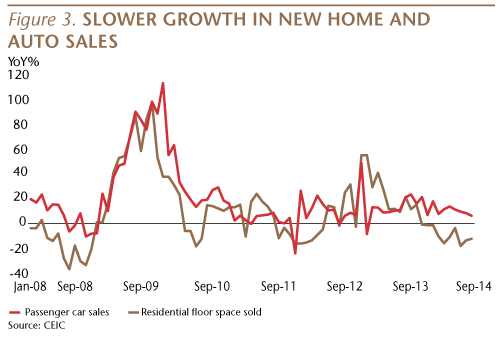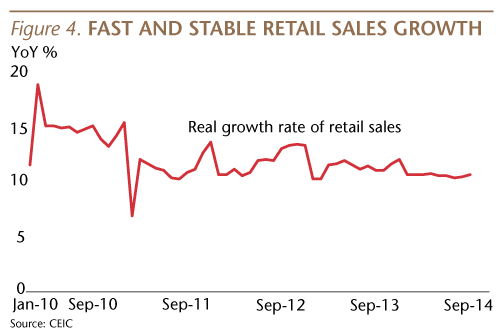China: Decelerating but Still Healthy
Q3 2014 macroeconomic data reveals a Chinese economy that is gradually decelerating to a still healthy and more sustainable growth rate.
GDP growth will be just above 7% this year, and slightly slower next year. Despite the negative media headlines, there are no signs of impending doom and Andy Rothman, Matthews Asia Investment Strategist, expects the property market to stabilize in the coming quarters. Strong growth in income and retail sales means China remains the world’s best consumption story.
Third quarter macroeconomic data reveals a Chinese economy that is gradually decelerating to a still healthy and more sustainable growth rate. This deceleration is inevitable—as the workforce has begun to shrink, as the base has become so large and as so much infrastructure and housing has already been built—and China’s leaders have resisted the urge to artificially boost growth. GDP growth will be just above 7% this year, and slightly slower next year. Despite the negative media headlines, there are no signs of impending doom and I expect the property market to stabilize in the coming quarters. Strong growth in income and retail sales means China remains the world’s best consumption story.
Looking Behind Headline GDP Growth
China’s GDP rose 7.3% in the third quarter, and with year-to-date growth of 7.4%, it is almost certain that full-year growth will be within the 7% to 7.5% range I had forecast at the start of the year. A look behind this headline number provides several interesting insights into the state of the economy.

First, last quarter’s growth rate came despite a very high base, as GDP growth was 7.8% in the third quarter of 2013—marking the fastest rate of growth last year.
Second, final consumption, which includes household and government spending, accounted for about 49% of GDP growth in the first three quarters of this year, compared to about 41% from investment.
Net exports—the value of exports minus the value of imports—accounted for about 10% of GDP growth, up from small negative contributions during the past two years. But this was likely due in large part to lower import prices rather than a revival of exports.
Third, the added value of the tertiary* part of the economy (services, retail and wholesale trade in addition to finance and real estate) rose faster than the added value of the secondary* part (manufacturing and construction). Furthermore, for the second consecutive year, the tertiary industry accounted for a larger share of GDP than secondary, providing further evidence of significant economic restructuring.

Slowed by Property
GDP growth is on target despite a significant negative drag from the residential property sector. New home sales declined 10% year-on-year (YoY) during the first three quarters (vs. +24% during the same period last year), leading residential investment to rise by only 11%, down from a 20% increase a year ago.

Slower housing sales also resulted in slower sales growth for cars and home appliances, putting a small dent into industrial output and retail sales.
But I believe the property market will soon stabilize, following the government’s recent decision to lift the obstacles for people wishing to upgrade to a nicer primary residence. (That move included lowering the cash down payment requirement to 30% from 60% for those who pay off their first mortgage and wish to buy a second house.) Although that change was made just late last month, the month-on-month growth rate of new home sales rebounded to 41% in September, compared to an average of 32% for that month during the previous seven years.
No Significant Stimulus
Healthy growth also came without significant stimulus from the government. None of the aspects of the economy where stimulus should be visible—growth in credit, infrastructure construction or fiscal spending (all of which are government-controlled)—reveal an effort to reflate growth. Rather, the clear signal is that the Communist Party leadership is comfortable with the fact that on a YoY-basis, most aspects of China’s economy will continue to grow more slowly every year, on average, for the foreseeable future. This is a very positive development, one which investors also need to embrace. Investors should also remember that because of the much larger base, 7% growth today generates a much larger incremental increase in economic activity than 10% growth did a decade ago.
Consumer Still King
China remains the world’s best consumption story. Inflation-adjusted (real) retail sales rose 10.8% YoY last month, just a bit slower from last September’s 11.2% pace due to slower growth in auto sales and the impact of the continuing anti-corruption campaign. (In the U.S., retail sales are up about 2% this year.)

Strong consumer spending is supported by continued rapid income growth. Inflation-adjusted urban household disposable income rose 6.9% YoY during the first three quarters, compared to 7% for all of last year. Real rural cash income is up 9.7%, compared to 9.3% in 2013.
Andy Rothman
Investment Strategist
Matthews Asia
